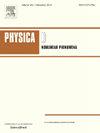Fermi-Pasta-Ulam-Tsingou晶格非线性动力学中五波共振的作用
IF 2.7
3区 数学
Q1 MATHEMATICS, APPLIED
引用次数: 0
摘要
我们研究了任意N个相互作用粒子的(α+β) Fermi-Pasta-Ulam-Tsingou晶格(简称FPUT晶格)的动力学,在足够小的非线性条件下,可以使用波湍流理论的工具找到Birkhoff-Gustavson型的范式。具体来说,我们发展了导致所谓的四波共振相互作用的Zakharov方程及其由Krasitskii扩展到五波共振相互作用的理论,但我们引入了一个重要的新特征:通过坚持即使是这些范式中的一般项也只包含共振相互作用,我们得到了独特的正则变换和范式,这些正则变换和范式产生了原始FPUT晶格的解析近似,这些近似具有大量精确的二次守恒律,超出了哈密顿量的二次部分。我们将新方程称为“精确共振演化方程”,并研究了它们的性质。首先,由于它们仅由精确共振项组成,因此在海森堡表示中演化非常缓慢,因此我们采用大时间步长的数值方法来获得有关动力学的相关信息,例如李雅普诺夫指数。其次,我们引入并成功地执行了一些测试,例如范式变换的收敛性和截断误差验证,通过量化这些方程的解对原始FPUT晶格动力学的近似程度来验证我们的精确共振演化方程。第三,我们利用我们的理论基础(基于所谓的共振簇矩阵),根据发现的新的二次不变量,提出并实现一种方法,基于有限时间李雅普诺夫指数计算应用于长时间动力学,量化非线性水平,在非线性水平上,原始FPUT晶格被精确共振演化方程很好地近似。本文提出的大多数数值实验都是在N=9的情况下进行的,但所提出的理论和数值方法对任意N值都是有效的。我们得出结论,当N能被3整除时,在足够小的非线性下,FPUT晶格的动力学和非平凡超混沌是由5波共振相互作用控制的,在定性和定量上与本文所发展的理论一致。本文章由计算机程序翻译,如有差异,请以英文原文为准。

On the role of 5-wave resonances in the nonlinear dynamics of the Fermi–Pasta–Ulam–Tsingou lattice
We study the dynamics of the Fermi–Pasta–Ulam–Tsingou lattice (FPUT lattice, for short) for an arbitrary number of interacting particles, in regimes of small enough nonlinearity so that a Birkhoff-Gustavson type of normal form can be found using tools from wave-turbulence theory. Specifically, we develop the theory that leads to the so-called Zakharov equation for 4-wave resonant interactions and its extension to 5-wave resonant interactions by Krasitskii, but we introduce an important new feature: by insisting that even the generic terms in these normal forms contain resonant interactions only, we obtain unique canonical transformations and normal forms that give rise to analytical approximations to the original FPUT lattice that possess a significant number of exact quadratic conservation laws, beyond the quadratic part of the Hamiltonian. We call the new equations “exact-resonance evolution equations” and examine their properties. First, because they consist of exact-resonant terms only, the evolution is very slow in the Heisenberg representation and we implement numerical methods with large time steps to obtain relevant information about the dynamics, such as Lyapunov exponents. Second, we introduce and execute successfully a number of tests, such as convergence of the normal form transformation and truncation error verification, to validate our exact-resonance evolution equations, by quantifying how well the solution to these equations serves to approximate the original FPUT lattice dynamics. Third, we use our theoretical underpinnings (based on the so-called resonant cluster matrix) in terms of the new quadratic invariants found, to propose and implement a method, based on finite-time Lyapunov exponent calculations applied to long-time dynamics, to quantify the level of nonlinearity at which the original FPUT lattice is well approximated by the exact-resonance evolution equations. Most of the numerical experiments presented are done in the case , but the theory and the numerical methods presented are valid for arbitrary values of . We conclude that, when is divisible by 3, at small enough nonlinearity the FPUT lattice’s dynamics and nontrivial hyperchaos are governed by 5-wave resonant interactions, in qualitative and quantitative agreement with the theory developed in this paper.
求助全文
通过发布文献求助,成功后即可免费获取论文全文。
去求助
来源期刊

Physica D: Nonlinear Phenomena
物理-物理:数学物理
CiteScore
7.30
自引率
7.50%
发文量
213
审稿时长
65 days
期刊介绍:
Physica D (Nonlinear Phenomena) publishes research and review articles reporting on experimental and theoretical works, techniques and ideas that advance the understanding of nonlinear phenomena. Topics encompass wave motion in physical, chemical and biological systems; physical or biological phenomena governed by nonlinear field equations, including hydrodynamics and turbulence; pattern formation and cooperative phenomena; instability, bifurcations, chaos, and space-time disorder; integrable/Hamiltonian systems; asymptotic analysis and, more generally, mathematical methods for nonlinear systems.
 求助内容:
求助内容: 应助结果提醒方式:
应助结果提醒方式:


